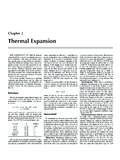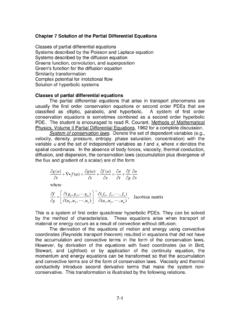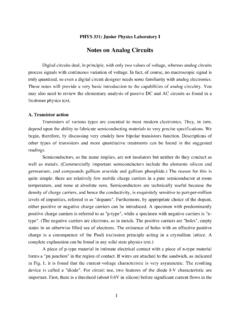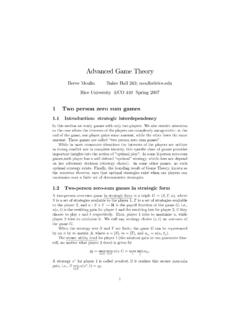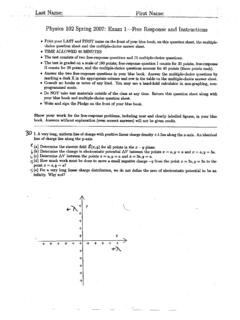Transcription of Chapter 8 One-Dimensional Laminar Flows
1 Chapter 8 Laminar Flows with Dependence on One Dimension Couette flow Planar Couette flow Cylindrical Couette flow Planer rotational Couette flow Hele-Shaw flow Poiseuille flow Friction factor and Reynolds number Non-Newtonian fluids Steady film flow down inclined plane Unsteady viscous flow Suddenly accelerated plate Developing Couette flow Reading Assignment: Chapter 2 of BSL, Transport Phenomena One dimensional (1-D) flow fields are flow fields that vary in only one spatial dimension in Cartesian coordinates. This excludes turbulent Flows because it cannot be One-Dimensional . Acoustic waves are an example of 1-D compressible flow.
2 We will concern ourselves here with incompressible 1-D flow fields that result from axial or planar symmetry. Cartesian, 1-D incompressible Flows do not have a velocity component (other than possibly a uniform translation) in the direction of the spatial dependence because of the condition of zero divergence. Thus the nonlinear convective derivative disappears from the equations of motion in Cartesian coordinates. They may not disappear with curvilinear coordinates. 333333,332323()00(0)000,1,jijijjxvxvxvvv vvxvvpptx = = = == = === = + = + += vvvvvff2j We can demonstrate that this relation may not apply in curvilinear coordinates by considering an example with cylindrical polar coordinates.
3 Suppose that the only nonzero component of velocity is in the direction and the only spatial dependence is on the r coordinate. The radial component of the convective derivative is non-zero due to centrifugal forces. 8-1 []2[0, ( ), 0]rvrvr = = vvv The Flows can be classified as either forced flow resulting from the gradient of the pressure or the potential of the body force or induced flow resulting from motion of one of the bounding surfaces. Some flow fields that result in 1-D flow are listed below and illustrated in the following figure (Churchill, 1988) 1. Forced flow through a round tube 2.
4 Forced flow between parallel plates 3. Forced flow through the annulus between concentric round tubes of different diameters 4. Gravitational flow of a liquid film down an inclined or vertical plane 5. Gravitational flow of a liquid film down the inner or outer surface of a round vertical tube 6. Gravitational flow of a liquid through an inclined half-full round tube 7. Flow induced by the movement of one of a pair of parallel planes 8. Flow induced in a concentric annulus between round tubes by the axial movement of either the outer or the inner tube 9. Flow induced in a concentric annulus between round tubes by the axial rotation of either the outer or the inner tube 10.
5 Flow induced in the cylindrical layer of fluid between a rotating circular disk and a parallel plane 11. Flow induced by the rotation of a central circular cylinder whose axis is perpendicular to parallel circular disks enclosing a thin cylindrical layer of fluid 12. Combined forced and induced flow between parallel plates 13. Combined forced and induced longitudinal flow in the annulus between concentric round tubes 14. Combined forced and rotationally induced flow in the annulus between concentric round tubes 8-2 8-3 Geometry and conditions that produce One-Dimensional velocity fields (Churchill, 1988) Couette Flow The Flows when the fluid between two parallel surfaces are induced to flow by the motion of one surface relative to the other is called Couette flow.
6 This is the generic shear flow that is used to illustrate Newton's law of viscosity. Pressure and body forces balance each other and at steady state the equation of motion simplify to the divergence of the viscous stress tensor or the Laplacian of velocity in the case of a Newtonian fluid. Planar Couette flow. (case 7). 22330,1,2jdvdjdxdx = == The coordinates system can be defined so that v = 0 at x3 = 0 and the j component of velocity is non-zero at x3 = L. 330,0,,jjjvxvUxLj=====1,2 The velocity field is 8-4 3jjUxvL=. The shear stress can be determined from Newton's law of viscosity. 33,1jjjdvUjdxL = = =,2 Cylindrical Couette flow.
7 The above example was the translational movement of two planes relative to each other. Couette flow is also possible in the annular gap between two concentric cylindrical surfaces (cases 8 and 9) if secondary Flows do not occur due to centrifugal forces. We use cylindrical polar coordinates rather than Cartesian and assume vanishing Reynolds number. The only independent variable is the radius. ()[]()[]()[]()()22101, may not vanishif Reynolds number is high10, may not vanishif Reynolds number is high1010 Newtonian fluid0rrrrrrrrzzzrvrrrrrrrrrrrrrrvrrrvrr r = = =+= == = = The stress profile can be calculated by integration.
8 1212222rrrrrrrrzrzrzrrrrrrrrrr ======== The boundary conditions on velocity depend on whether the cylindrical surfaces move relative to each other as a result of rotation, axial translation, or both. 120,(0, , ),zrrUUrr ====vv The velocity field for cylindrical Couette flow of a Newtonian fluid is . 8-5 121112121log( / )log( / )zzUrrvrrrrrrUvrrr = =r Planer rotational Couette flow. The parallel plate viscometer has the configuration shown in case 10. The system is not strictly 1-D because the velocity of one of the surfaces is a function of radius. Also, there is a centrifugal force present near the rotating surface but is absent at the stationary surface.
9 However, if the Reynolds number is small enough that secondary Flows do not occur, then the velocity at a given value of the radius may be approximated as a function of only the z distance in the gap. The differential equations at zero Reynolds number are as follows. []2200, Newtonianfluidzzvz == = Suppose the bottom surface is stationary and the top surface is rotating. Then the boundary conditions are as follows. 0,02,vzvrz === =L The stress and velocity profiles are as follows. ()2()/2/ , NewtonianfluidzzrrrLvrzL == = The stress is a function of the radius and if the fluid is non-Newtonian, the viscosity may be changing with radial position.
10 Plane-Poiseuille and Hele-Shaw flow Forced flow between two stationary, parallel plates, case 2, is called plane-Poiseuille flow or if the flow depends on two spatial variables in the plane, it is called Hele-Shaw flow. The flow is forced by a specified flow rate or a specified pressure or gravity potential gradient. The pressure and gravitational potential can be combined into a single variable, P. 8-6wherepPPpgh += =+f The product gh is the gravitational potential, where g is the acceleration of gravity and h is distance upward relative to some datum. The pressure, p, is also relative to a datum, which may be the datum for h.
